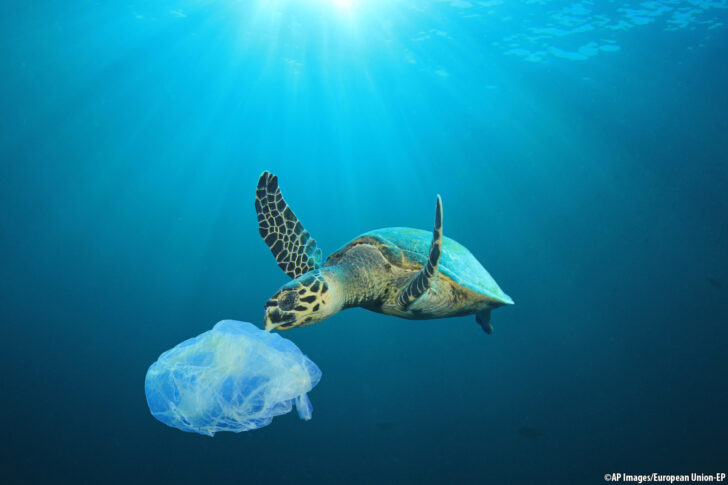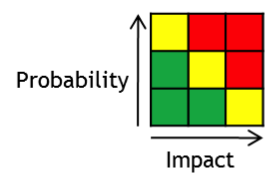Microplastics in our oceans

Microplastics are increasingly concerning to society because they are suspected of causing harm to humans and the environment. A recent paper determined the risk of microplastics in oceans based on real environmental concentrations.
Plastic is ubiquitous, its benefits undisputed - it is a malleable and long-lasting material, but for some time now plastic and its use has been the subject of public debate. A significant amount of the plastic produced ends up in the environment (one study estimated 79% of all plastic waste), thus polluting nature. Once plastic is there, its durability means it remains for decades and only slowly breaks down into smaller particles. The resulting microplastic has now been the subject of research and public discourse for more than 10 years: what impact do these plastic tiny particles have on humans and our living environment, in the soil, the air and in water bodies?
What is microplastic anyway?
First reports of small, floating plastic particles date back as early as the 1970s, but the term "microplastic" was not defined until 30 years later. Today, this is commonly understood to mean particles of synthetically produced polymer that are less than five millimeters long in their largest dimension. Why exactly five millimeters? From a scientific point of view, this limit makes no obvious sense. It was simply proposed that way in 2009. Since then, most toxicological studies and measurements of microplastic concentrations in the environment have followed this definition.
But that's not all. The words "particle" and "plastic" encompass a variety of possibilities. For example, microplastics can exist in a variety of forms, such as fibers, spheres, cubes, or even completely misshapen particles that cannot be directly assigned to any of the previous categories. Plastics also comprise a wide range of synthetic polymers. If the different polymers and possible shapes are then combined, the result is an immensely large number of possible "particles" that are considered microplastics.
| Polymertyp | Kürzel | Verwendung |
| Polyethylenterephthalat | PET | Kunststoffflaschen |
| Polypropylen | PP | Verpackungen |
| Polyethylen | PE | Verpackungen |
| Polystyrol | PS | Folien oder Schaumstoff (expandiert: Styropor) |
| Polyvinylchlorid | PVC | Rohre, Schallplatten |
Different types of polymers fall under the term plastic: Commonly known polymer types with their abbreviations and possible uses.
Environmental risk assessment explained shortly
So how does one know if microplastics are dangerous to the creatures in our environment? The common method for finding an answer to this is environmental risk assessment. It combines data from two separate analyses: hazard and exposure analysis.
Toxicity studies try to find out what concentration of the stressor in question (for example, the microplastic particles or other chemicals) is dangerous to a living being. For such studies, there are detailed test procedures that researchers can use (companies that want to market a substance are required to perform such tests according to the guidelines for successful registration). Results from studies to date do not give a clear picture of the toxicity of microplastics: some have found effects on, for example, reproductive capacity or other endpoints (e.g. expression of specific genes), while others have not observed any effects at all.
In ecotoxicology, a special methodology called "Species Sensitivity Distribution" (or SSD for short) is used to pool many such toxicity data. The basic idea behind this is that it allows several species of a habitat to be recorded in a distribution in the order of their sensitivity to the stressor under investigation. A higher concentration means that a species is less sensitive (because a substance is more toxic if smaller amounts can already cause damage). The new study explicitly examined only the effect of plastic polymers, i.e. the inherent toxicity of plastic. Additives in the polymer matrix (e.g., flame retardants or nanoparticles) and chemicals adsorbed from the environment were not part of the study.
However, determining the toxicity of a substance is only the first step. In the spirit of Paracelsus' well-known statement "The dose makes the poison", an (environmental) risk analysis must determine or estimate the exposure of organisms in the habitat, the environmental concentration. Common methods for exposure analysis include mathematical models based on production data and substance flows or data from field measurements. There are limitations to both types of determination, e.g., in sample collection, processing, or analysis, or the availability of data on production quantities of a substance. Nevertheless, the present study is the first to consider only real measurements from the marine environment - and quite a few at that: A total of 1056 measurements were included in the analysis.

Risk is the probability that a negative effect (impact) will occur. The matrix illustrates this with a traffic light system: If a negative effect is very unlikely to occur, the risk is lower. On the other hand, a moderate negative effect that is very likely to occur represents a high risk. Image source: Wikimedia Commons
Once this data has been collected, the actual risk assessment can now be carried out by comparing the toxicity of the substance with the environmental exposure. This results in the risk factor. If the measured or calculated concentration in the environment is higher than a defined concentration (the so-called "Predicted No Effect Concentration", PNEC, at which 95% of the species are not negatively affected), the living organisms in the environmental compartment under investigation are in danger from this substance. In this case, the risk factor is greater than one. However, if the environmental concentration is lower, there is no risk at the moment (and the risk factor is less than one).
Refined risk assessment methodology
This procedure has now been applied in the recent paper, but with a more refined methodology, since every measurement is subject to variation. Toxicity data often come from tests of short duration (to determine acute toxicity), which are less informative than long-term tests (to determine chronic toxicity). Thus, the method used includes all variances as well as safety factors to convert acute to chronic data. Each analysis was then simulated 10,000 times (a so-called Monte Carlo routine). Thus, not only two average values, derived from the toxicity and exposure data, but two normal distributions are examined for possible overlaps. Therefore, the result of the risk assessment is not just one value and a binary conclusion: risk or no risk. Instead, the percentage of overlap of the two distributions is reported and the risk factor gives a better picture of the situation because any uncertainties are accounted for.
Do microplastics pose a risk in oceans?
This question is still not easy to answer. Surprisingly, 80% of the data included in the SSD is based on the highest concentration tested, where still no negative effect was found. This suggests that the toxicity of microplastics is generally low. A follow-up study was the first to examine the hazards of the even smaller nanoplastic. According to the authors, the nanoplastic is even less dangerous than the larger microplastic and also than engineered nanomaterials. This is a first rebuttal of the hypothesis that toxicity increases with decreasing particle size.
Worldwide, there are an average of 1,500 microplastic particles in one cubic meter of water. That sounds like a lot. However, if you look at the median, there are only 1.6 particles per cubic meter of water. For a more differentiated view, the data set was also examined for other factors. For example, the authors identified geographic location as a possible reason for differences. Concentrations differed between the Mediterranean and Pacific waters, for example, or between measurements near land and those in the open ocean.
According to the study, a risk is currently very unlikely. Only in a very few cases are environmental concentrations high enough to be toxic, so a risk cannot be completely ruled out. However, the average risk factor would have to increase 2500-fold to reach the limit value of one. Therefore, even if plastic inputs continue to increase, there is no immediate risk to marine life.
What a risk analysis can do - and what it cannot
A risk analysis can only reflect what the data on which it is based allows. Thus, the study identified two factors that should be considered when interpreting this assessment. The net size of the sampling devices has an influence on the measured environmental concentration. For example, in the Mediterranean, only nets with a mesh size of 200 µm or larger were used. The relatively low concentrations (average: 2.4 particles/m3) should therefore be taken with caution. If smaller mesh sizes had been used, more particles might have been trapped and detected.
The other problem concerns the difference in microplastic particles in the laboratory and in the environment. The data sets for exposure and hazard analysis differ greatly in this regard. The most tested polymer in the lab is PS with 56% of the data points. In the environment, however, PS accounts for only 4% of microplastics found. Much more PE and PP are found in the world's oceans (36% and 27%, respectively), and the latter has thus far never been studied for toxicity. Likewise, the particles studied in the lab were mostly much smaller than those fished from the sea. This illustrates the need to design toxicity studies with microplastics also found in the living environment in order to increase the validity of future environmental risk assessments.
Author: Alex von Wyl
Original publication: Aquatic Toxicology: Adam et al. (2020) - Probabilistic environmental risk assessment of microplastics in marine habitats
Image source (Title image): ©Richard Carey - stock.adobe.com